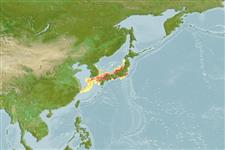Classification / Names
आम नाम | उपशब्द | Catalog of Fishes(वर्ग, प्रजाति) | ITIS | CoL | WoRMS | Cloffa
मिक्सिनी (हैगफिश) (hagfishes) >
Myxiniformes (Hagfishes) >
Myxinidae (Hagfishes) > Eptatretinae
Etymology: Eptatretus: hepta (Gr.), seven; tretos (Gr.), perforated (i.e., with holes), referring to seven gill apertures on what would later be described as Homea banksii (=E. cirrhatus) [range within genus is 6-14 pairs of gill apertures]. (See ETYFish); walkeri: In honor of Harold J. Walker, Jr., Collections Manager, Scripps Institution of Oceanography, for help in providing hagfish specimens and data, and for contributions to ichthyology. (See ETYFish).
Environment: milieu / climate zone / depth range / distribution range
पारिस्थितिकी
समुद्री ड़िमरसल; गैर प्रवासी; गहराई सीमा 75 - 120 m (Ref. 51420). Deep-water
वितरण
देश | ऐफ ऐ ओ क्षेत्र | Ecosystems | संयोग | Point map | भूमिका | Faunafri
Northwest Pacific: Japan.
आकार / वज़न / Age
Maturity: Lm ? range ? - ? cm
Max length : 51.8 cm TL पुल्लिंग / अलिंग; (Ref. 51420)
Short description
आकृति विज्ञान | मौरफोमैटरिक्स
Six pairs of gill pouches (GP) and apertures (GA); GA closely spaced in a linear or slightly irregular pattern; each GA with pale margin. Fused cusps 3/2, total cusps 38-44. Prebranchial slime pores 16-20, total pores 69-79. Ventral finfold poorly developed to vestigial. Eyespots faint or absent (Ref. 51420).
Life cycle and mating behavior
परिपक्व अवधि | पुनरुत्पत्ति | मछलीऔ का अंडे देना | अंडे | Fecundity | लार्वा
McMillan, C.B. and R.L. Wisner, 2004. Review of the hagfishes (Myxinidae, Myxiniformes) of the northwestern Pacific Ocean, with descriptions of three new species, Eptatretus fernholmi, Paramyxine moki, and P. walkeri. Zool. Stud. 43(1):51-73. (Ref. 51420)
IUCN Red List Status (Ref. 130435)
Threat to humans
Harmless
Human uses
अधिक जानकारी
देशऐफ ऐ ओ क्षेत्रEcosystemsसंयोगभूमिकाStocksपारिस्थितिकीआहारखाद्य पदार्थआहार खपतखोराक
आम नामउपशब्दचपायचयपरभक्षीईकोटोकसीकोलौजीपुनरुत्पत्तिपरिपक्व अवधिमछलीऔ का अंडे देनाSpawning aggregationFecundityअंडेEgg development
Age/Sizeबाढ़Length-weightLength-lengthLength-frequenciesमौरफोमैटरिक्सआकृति विज्ञानलार्वालारवल गतिकीभर्तीबहुतायतBRUVS
संदर्भजलीयकृषिजलीयकृषि रूपरेखाखींचआनुवंशिकीElectrophoresesहैरेटिबिलटीबीमारीप्रक्रमणNutrientsMass conversion
सहयोगीयोतस्वीरेStamps, Coins Misc.ध्वनिसिगुयटिरारफ्तारतैरने के प्रकारगिल क्षेत्रOtolithsदिमागदृष्टि
साधन
Special reports
Download XML
इंटरनेट स्रोत
Estimates based on models
Phylogenetic diversity index (Ref.
82804): PD
50 = 0.5000 [Uniqueness, from 0.5 = low to 2.0 = high].
Bayesian length-weight: a=0.00204 (0.00092 - 0.00452), b=2.93 (2.73 - 3.13), in cm total length, based on LWR estimates for this (Sub)family-body shape (Ref.
93245).
Trophic level (Ref.
69278): 4.2 ±0.7 se; based on size and trophs of closest relatives
Fishing Vulnerability (Ref.
59153): Moderate vulnerability (41 of 100).
